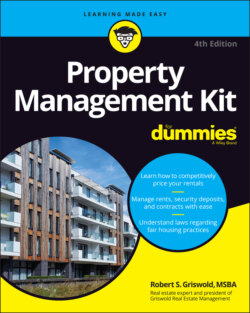Читать книгу Property Management Kit For Dummies - Robert S. Griswold - Страница 92
Performing turnover maintenance
ОглавлениеMost of the items requiring maintenance in your vacant unit are minor, such as sticky closet doors, loose doorknobs and towel bars, and burned-out light bulbs. But be sure that you carefully and regularly evaluate the current condition of all systems and equipment, including plumbing; electrical; appliances; and heating, ventilating, and air conditioning (HVAC). Keep the following pointers in mind:
Carefully inspect all plumbing fixtures. Look for leaky faucets, clogged aerators, or running toilets, and check whether all drains work adequately. Test the angle stops and shutoff valves for all toilets, washers, dishwashers, and faucets, including under each sink, and look for signs of leakage. Even small leaks can be major problems if they’re not detected and repaired quickly. Though leaks in drains are difficult to detect because they’re not pressurized, look for telltale signs of water on the ceilings of downstairs units from drain leaks in upstairs units.
Inspect and test the electrical components. Make sure that the circuit breakers or fuses are all in place and operating properly. Replace burned-out light bulbs, and check light switches and outlets. If possible, verify that the cable or satellite television and telephone lines are working too.
Inspect each appliance to make sure that it’s operating properly. Stoves and ovens contain modular parts; you can replace the burner drip pans and control knobs very easily because replacement parts are readily available for most major appliances. Run the dishwasher through a cycle, and look carefully for any signs of leaks around the pressurized supply line, the door gasket, or underneath near the pump housing (where any leaks indicate you have a cracked tub and need to immediately replace the dishwasher).
Conserve energy by turning off the water heater, furnace, and air conditioning units at the breaker and setting the refrigerator/freezer to low. Your turnover work should also include cleaning or replacing all filters — air (furnace and A/C) and water (refrigerator and some water heaters). This simple, low-cost item greatly improves energy efficiency and lowers the wear on the equipment. Keep records indicating the date when the filters were changed (you can write in permanent marker right on the filter), and be sure to remind your tenants when they should be changed again.Tenants are becoming increasingly aware of the importance of conservation and energy efficiency. If you install water-saving fixtures, pilotless ignition gas stoves and water heaters or tankless water heaters, weatherproofing, insulated windows and doors, and energy-efficient appliances, you’ll have a competitive advantage in the rental marketplace. Be sure to emphasize your green efforts in promoting your rental property.
Check the pool/spa/water features. If your property has a pool, spa, or any water features, have a professional evaluate its condition and provide a written report documenting their findings, including the state of the equipment and the water quality. Poor water quality can create serious health issues, so always test all water systems to minimize the risk to people and animals. This evaluation establishes a baseline that can head off any tenant complaints down the road.
Perform maintenance that will minimize the likelihood of pests. Caulk all cracks around the windows, foundations, drains, pipes, and any other items that penetrate the building envelope and may allow pests to enter the unit. Almost every rental property needs pest control at some point. Occasional sightings of cockroaches or ants in search of water or food are commonplace, and consumer products are available to handle these limited situations. But use professional exterminators to treat more significant problems, and talk to your exterminator about establishing a regular schedule for follow-ups to make sure that your unit stays reasonably pest-free.The increase in bedbug infestations over the past 20 years can be a real problem for landlords, so you should seriously consider ordering a preoccupancy inspection or certification to ensure that the property is bedbug-free when your tenant takes occupancy. An inspection for bedbugs and other pests before your tenant moves in provides a baseline, showing that bedbugs weren’t present at that time. That doesn’t mean you shouldn’t aggressively respond to eradicate any future infestations, but effective pest control to minimize issues requires the full cooperation of the tenant, the landlord, and the pest-management professional. For more info about bedbugs, flip to Chapter 19.
